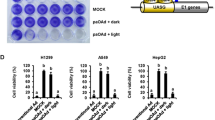Abstract
A main issue for further clinical progress of cancer gene therapy is to develop technologies for efficient and specific delivery of therapeutic genes to tumor cells. In this work, we describe a photochemical treatment that substantially improves gene delivery by adenovirus, one of the most efficient gene delivery vectors known. Transduction of two different cell lines was studied by microscopy, flow cytometry, and an enzymatic assay, employing a β-galactosidase–encoding adenovirus. The photochemical treatment induced a >20-fold increase in gene transduction, compared with conventional adenovirus infection, both when measured as the percentage of cells transduced, and when measured as the total β-galactosidase activity in the cell population. The effect was most pronounced at lower virus doses, where in some cases the same transduction efficiency could be achieved with a 20 times lower virus dose than with conventional infection. Photochemical treatments are already in clinical use for cancer therapy, and generally are very specific and have few side effects. The photochemical internalization technology described thus has a clear potential for improving both the efficiency and the specificity of gene delivery in cancer gene therapy, making it possible to achieve efficient site-specific in vivo gene delivery by adenoviral vectors.
This is a preview of subscription content, access via your institution
Access options
Subscribe to this journal
Receive 12 print issues and online access
$259.00 per year
only $21.58 per issue
Buy this article
- Purchase on Springer Link
- Instant access to full article PDF
Prices may be subject to local taxes which are calculated during checkout





Similar content being viewed by others
References
Verma IM, Somia N . Gene therapy — promises, problems and prospect Nature 1997 389: 239–242
Anderson WF . Human gene therapy Nature 1998 392: 25–30
Berg K, Selbo PK, Prasmickaite L et al. Photochemical internalization: a novel technology for delivery of macromolecules into cytosol Cancer Res 1999 59: 1180–1183
Høgset A, Prasmickaite L, Tjelle TE, Berg K . Photochemical transfection: a new technology for light-induced, site-directed gene delivery Hum Gene Ther 2000 11: 869–880
Selbo PK, Sivam G, Fodstad Ø, Sandvig K, Berg K . Photochemical internalisation increases the cytotoxic effect of the immunotoxin MOC31-gelonin Int J Cancer 2000 87: 853–859
Selbo PK, Sandvig K, Kirveliene V, Berg K . Release of gelonin from endosomes and lysosomes to cytosol by photochemical internalization Biochim Biophys Acta 2000 1475: 307–313
Prasmickaite L, Høgset A, Berg K . Evaluation of different photosensitizers for use in photochemical gene transfection Photochem Photobiol 2001 73: 388–395
Prasmickaite L, Høgset A, Tjelle TE, Olsen VM, Berg K . The role of endosomes in gene transfection mediated by photochemical internalisation J Gene Med 2000 2: 477–488
Høgset A, Prasmickaite L, Hellum M et al. Photochemical transfection; a technology for efficient light directed gene delivery In: Saltzman WM, Luo D, eds Synthetic DNA Delivery Systems Austin: Landes Bioscience Publishers 2002
Dash PR, Read ML, Barrett LB, Wolfert MA, Seymour LW . Factors affecting blood clearance and in vivo distribution of polyelectrolyte complexes for gene delivery Gene Ther 1999 6: 643–650
Nemerow GR, Stewart PL . Role of alpha(v) integrins in adenovirus cell entry and gene delivery Microbiol Mol Biol Rev 1999 63: 725–734
Leopold PL, Kreitzer G, Miyazawa N et al. Dynein- and microtubule-mediated translocation of adenovirus serotype 5 occurs after endosomal lysis Hum Gene Ther 2000 11: 151–165
Greber UF, Willetts M, Webster P, Helenius A . Stepwise dismantling of adenovirus 2 during entry into cells Cell 1993 75: 477–486
Leopold PL, Ferris B, Grinberg I, Worgall S, Hackett NR, Crystal RG . Fluorescent virions: dynamic tracking of the pathway of adenoviral gene transfer vectors in living cells Hum Gene Ther 1998 9: 367–378
Hansen J, Qing K, Kwon HJ, Mah C, Srivastava A . Impaired intracellular trafficking of adeno-associated virus type 2 vectors limits efficient transduction of murine fibroblasts JVirol 2000 74: 992–996
Hitt M, Bett AJ, Addison CL, Prevec L, Graham FL . Techniques for human adenovirus vector construction and characterization Methods Mol Genet 1995 7: 13–30
Cantwell MJ, Sharma S, Friedmann T, Kipps TJ . Adenovirus vector infection of chronic lymphocytic leukemia B cells Blood 1996 88: 4676–4683
Tang D-C, Jennelle RS, Shi Z, Garver RI Jr, Carbone DP, Loya F, Chang C-H, Curiel DT . Overexpression of adenovirus-encoded transgenes from the cytomegalovirus immediate early promoter in irradiated tumor cells Hum Gene Ther 1997 8: 2117–2124
Wickham TJ . Targeting adenovirus Gene Ther 2000 7: 110–114
Miller N, Whelan J . Progress in transcriptionally targeted and regulatable vectors for genetic therapy Hum Gene Ther 1997 8: 803–815
Alemany R, Balague C, Curiel DT . Replicative adenoviruses for cancer therapy Nat Biotechnol 2000 18: 723–727
Dougherty TJ, Gomer CJ, Henderson BW et al. Photodynamic therapy J Natl Cancer Inst 1998 90: 889–905
Selbo PK, Sivam G, Fodstad Ø, Sandvig K, Berg K . In vivo documentation of photochemical internalization, a novel approach to site specific cancer therapy Int J Cancer 2001 92: 761–766
Pass HI . Photodynamic therapy in oncology: mechanisms and clinical use J Natl Cancer Inst 1993 85: 443–456
Acknowledgements
We are very grateful to Dr Frank L Graham for providing the AdHCMV-lacZ adenovirus and to Dr Robin Parks for critically reading the manuscript. The work was supported by the Norwegian Research Council, the Norwegian Cancer Society and the Norwegian Ministry of Health.
Author information
Authors and Affiliations
Corresponding author
Rights and permissions
About this article
Cite this article
Høgset, A., Øvstebø Engesæter, B., Prasmickaite, L. et al. Light-induced adenovirus gene transfer, an efficient and specific gene delivery technology for cancer gene therapy. Cancer Gene Ther 9, 365–371 (2002). https://doi.org/10.1038/sj.cgt.7700447
Received:
Published:
Issue Date:
DOI: https://doi.org/10.1038/sj.cgt.7700447
Keywords
This article is cited by
-
Increased sensitivity of glioma cells to 5-fluorocytosine following photo-chemical internalization enhanced nonviral transfection of the cytosine deaminase suicide gene
Journal of Neuro-Oncology (2014)
-
Visible light regulates neurite outgrowth of nerve cells
Cytotechnology (2007)



